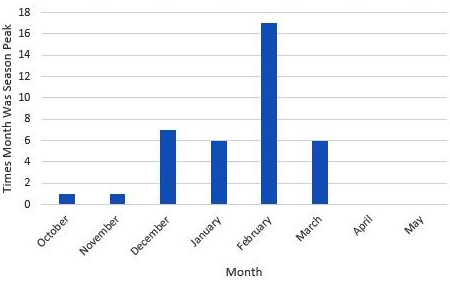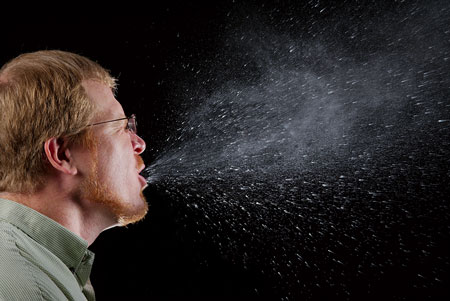*This course has been retired. There is no replacement course at this time. Please click here to view the current ATrain course listings.
Seasonal influenza differs from pandemic influenza in that it occurs each year, typically during a specific time of the year. Seasonal flu generally causes less illness because the population has some immunity left over from previous, similar influenza strains. In the Northern Hemisphere, winter is the time for seasonal influenza, but the exact timing and duration of influenza seasons vary. While influenza outbreaks can happen as early as October, activity usually peaks in January or later.
The figure below shows peak seasonal flu activity for the United States by month for the 1982–1983 through 2019-2020 flu seasons. The “peak month of flu activity” is the month with the highest percentage of respiratory specimens testing positive for influenza virus infection during that influenza season. During this 38-year period, flu activity most often peaked in February (17 seasons), followed by December (7 seasons), March (6 seasons), and January (6 seasons) (CDC, 2021, September 28).
Peak Month of Flu Activity
1982-1983 through 2019-2020

Source: CDC, September 28, 2021.
Seasonal Influenza Clinical Features
[Material from this section from Hall, E. (2021). Centers for Disease Control and Prevention. Epidemiology and Prevention of Vaccine-Preventable Diseases. 14th ed.].
Influenza is a contagious respiratory illness caused by influenza viruses. It can cause mild to severe illness resulting in hospitalization or even death. “Classic” influenza is characterized by the abrupt onset of fever, myalgia, sore throat, nonproductive cough, and headache. The fever is usually 101°F to 102°F and accompanied by prostration (bedridden).
The onset of fever is often so abrupt that the exact hour is recalled by the patient. Myalgias mainly affect the back muscles. Cough is believed to be a result of tracheal epithelial destruction. Additional symptoms may include runny nose, headache, substernal chest burning, and ocular symptoms such as eye pain and sensitivity to light.
The incubation period for influenza is usually 2 days but can vary from 1 to 4 days. The severity of illness depends on whether the immune system has been exposed to related virus variants. Somewhat surprisingly, only about 50% of infected people will develop the classic clinical symptoms of influenza.
Systemic symptoms and fever usually last from 2 to 3 days, rarely more than 5 days. They may be decreased by such medications as aspirin* or acetaminophen. Recovery is usually rapid, but some patients may have lingering depression and lack of strength or energy for several weeks.
*Aspirin should NOT be used for infants, children, or teenagers because they may be at risk for contracting Reye syndrome following an influenza infection.
Influenza Clinical Features
- Incubation period 2 days (range, 1–4 days)
- About 8% of U.S. population gets sick each season
- Sudden onset of symptoms
- Respiratory: cough, sore throat, runny or stuffy nose
- Systemic: fever, chills, headache, malaise, myalgia
- Gastrointestinal: vomiting, diarrhea
- Rapid recovery
Complications
[Material from this section from Hall, E. (2021). Centers for Disease Control and Prevention. Epidemiology and Prevention of Vaccine-Preventable Diseases. 14th ed.].
People most at risk of developing serious influenza-related complications include people age 65 years and older, people with chronic medical conditions (e.g., heart disease or diabetes), pregnant women, and young children, especially those younger than age 2 years. More common complications of influenza include secondary bacterial pneumonia (e.g., Streptococcus pneumoniae, Haemophilus influenzae, or Staphylococcus aureus), exacerbations of underlying respiratory conditions, otitis media, laryngotracheobronchitis, and bronchitis.
Other complications may include primary pneumonia, encephalitis, aseptic meningitis, transverse myelitis, myocarditis, pericarditis, Guillain-Barré syndrome, and Reye Syndrome. Reye syndrome is a complication that occurs almost exclusively in children taking aspirin, primarily in association with influenza B virus (or varicella zoster virus), and presents with severe vomiting and confusion, which may progress to coma due to swelling of the brain.
Most deaths due to influenza typically occur among people 65 years and older.
Influenza Complications
- Secondary bacterial pneumonia
- Exacerbations of underlying respiratory conditions
- Otitis media
- Laryngotracheobronchitis
- Bronchitis
- Other less common complications may occur
Transmission
Influenza is primarily a community-based infection that is transmitted in households and community settings. In humans, influenza is primarily transmitted from person to person via large virus-laden droplets that are generated when infected individuals cough or sneeze. These large droplets can then settle on the mucosal surfaces of the upper respiratory tracts of susceptible people who are nearby (within 6 feet).
Cone-Shaped Dispersion of Sneeze Particles

This photograph captures a sneeze in progress, revealing the plume of salivary droplets as they are expelled in a large cone-shaped array from this man’s open mouth, thereby dramatically illustrating the reason for covering your mouth when coughing or sneezing, in order to protect others from germ exposure. Source: James Gathany, CDC PHIL, 2009.
Transmission can also occur through direct or indirect contact with respiratory secretions, such as when touching surfaces contaminated with influenza virus and then touching the eyes, nose, or mouth. Adults can transmit influenza from the day before symptom onset to approximately 5 days after symptoms begin. Children can transmit influenza to others for 10 or more days.
Healthy adults may be able to infect others beginning 1 day before symptoms develop and up to 5 to 7 days after becoming sick. Some people, especially young children and people with weakened immune systems, might be able to infect others for an even longer time.
Watch this fascinating 3-minute video showing how influenza is transmitted and replicated.
Flu Attack! How a Virus Invades Your Body [3:39]
Source: NPR. https://www.youtube.com/watch?v=Rpj0emEGShQ
